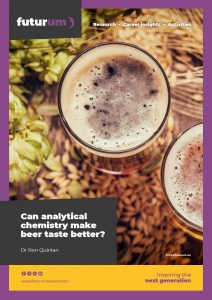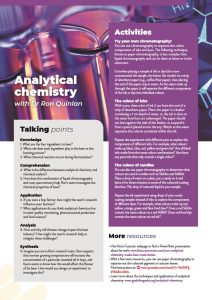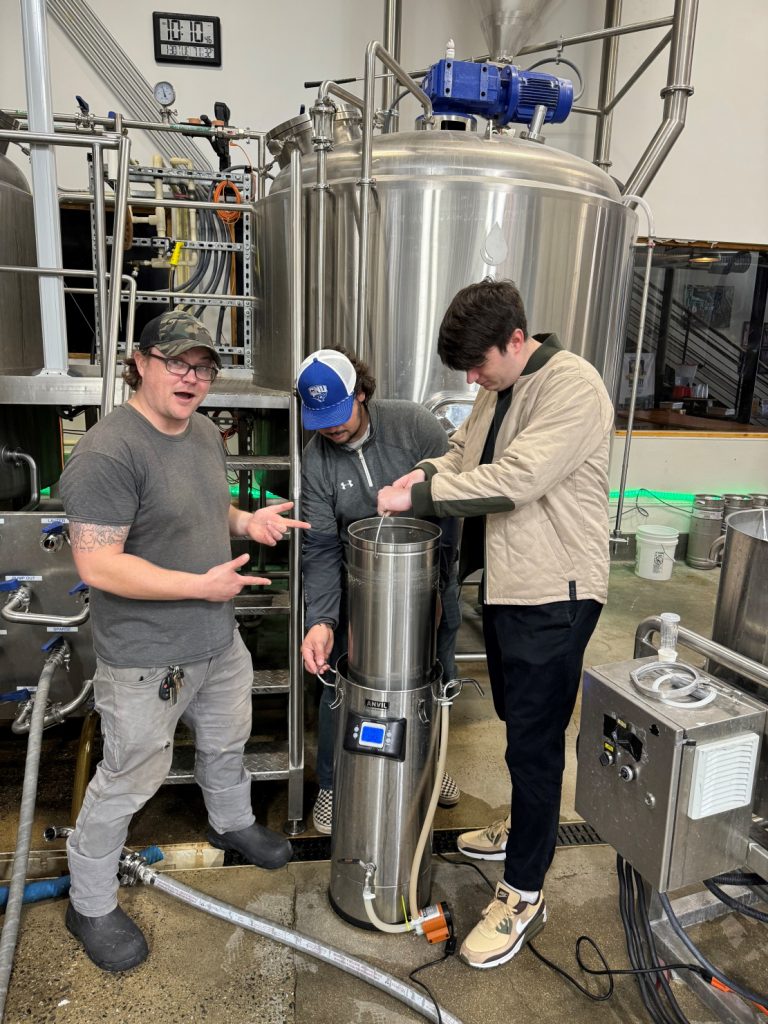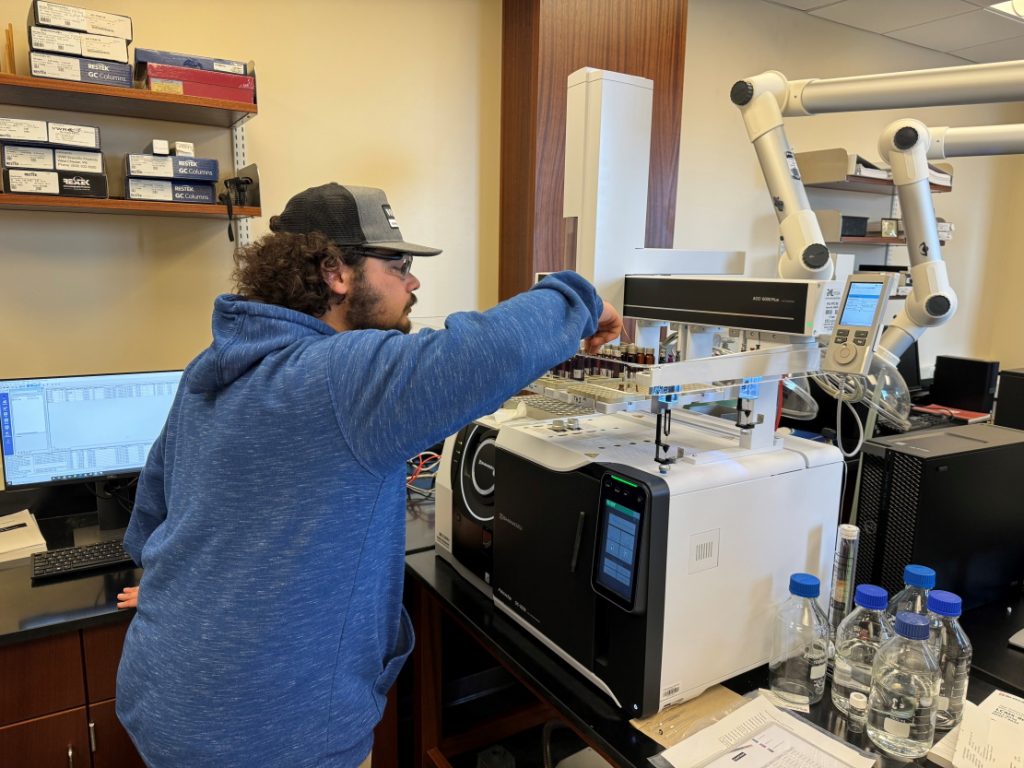Can analytical chemistry make beer taste better?
Since beer was invented thousands of years ago, brewers have been modifying, adapting and experimenting with their recipes. Subtle changes to a beer’s ingredients can have a noticeable impact on its flavour. At Christopher Newport University in the US, Dr Ron Quinlan is using analytical techniques to uncover the chemistry of beer. He hopes to demonstrate the real-world applications of analytical chemistry by helping brewers create the perfect pint.
Talk like an analytical chemist
Brewing — the process of producing beer, which involves soaking malt in water to release sugars, followed by fermentation to produce alcohol
Fermentation — the process by which, during brewing, enzymes in yeast convert sugar (glucose) into alcohol (ethanol) and carbon dioxide: C6H12O6 → 2C2H5OH + 2CO2
Hop — a flower from the hemp family of plants, used to give flavour, aroma and bitterness to beer
Liquid chromatography — an analytical technique to separate a complex liquid solution into its chemical components
Malt — a cereal grain (most commonly barley) that has been soaked in water to begin germination, then dried to prevent further germination
Mass spectrometry — an analytical technique to identify chemical compounds in a sample
Humans have been drinking beer for thousands of years. The world’s first beer recipe is found in an ancient prayer to Ninkasi, the goddess of beer, worshiped by inhabitants of ancient Mesopotamia. Workers building the Pyramids of Giza in ancient Egypt were given a daily ration of beer to keep them refreshed and hydrated. And beer is still important today. In 2019, the beer industry supported over 23 million jobs around the world and contributed $555 billion to the global economy. In many countries, beer is not only an integral part of society, but a source of national pride. From Heineken in the Netherlands to Guiness in Ireland, each beer has its own unique identity and flavour.
At Christopher Newport University, Dr Ron Quinlan is leading a team of analytical chemists and commercial brewers to uncover the chemical composition of beer. He hopes that by understanding how environmental conditions impact the chemistry of beer ingredients, brewers will have more control over the taste of their beers.
What is beer made from?
“Beer contains four key ingredients: malt, hops, yeast and water,” explains Kevin Kingsbury, Head Brewer at Tradition Brewing. Malt and hops contribute to the beer’s flavour, as well as providing health benefits due to the vitamins, essential oils and acids they contain. “Different combinations of these compounds can lead to designed changes in the beer’s bitterness, aroma and taste,” explains Kevin. Malt also creates the beer’s colour and provides the sugars which the yeast converts into alcohol during fermentation.
How do environmental conditions influence the taste of beer?
A beer’s flavour is dependent on its ingredients and the brewing process, thanks to the chemistry of the malt, hops and water, and the chemical changes that occur during fermentation. Most of a beer’s volume is water, so local water chemistry influences the beer’s taste. The specific chemical compounds found in malt and hops depend on the environment in which they are grown. “Changing the environmental conditions changes the chemical ratios within the same plant species,” explains Ron. “And changing the ratios of the chemicals in beer results in changes in the flavour.”
As climate change causes environmental conditions to change, brewers around the world will have to adapt if they are to preserve their signature tastes. “This research is exciting because we’re just beginning to understand how the growing environment of malt and hops influences the flavour of beer,” says Ron.
How is the team chemically analysing beer?
Ron and the team are combining two analytical techniques, liquid chromatography and mass spectrometry, to determine the chemical composition of beer and beer ingredients. Liquid chromatography separates a sample into its chemical components, then mass spectrometry analyses each individual component and identifies what chemical compounds it contains. “When we put the two techniques together, we can determine which compounds are present in the beer with very high accuracy and precision,” explains Celina Paoletta, a student in Ron’s lab.
The team uses these techniques to determine which compounds are produced by the hops and malt before they go into the beer. “We then track the compounds through the brewing process and into the finished beer,” says Chris Balog, another student. “This allows us to discover previously unidentified chemical reactions taking place during the brewing process.”
Through this research project, Ron is keen to highlight the real-world applications of analytical chemistry. “It’s easy for analytical chemists to get caught up in their lab-based methods,” he explains. “Collaborating with industry partners, like Tradition Brewing, means we are working on research that has an impact on society.” This partnership also means students gain practical experience of applying their analytical chemistry knowledge to address real-world challenges in a fun and engaging project.
What has the team discovered?
So far, the team has observed that hops and malt grown in different environments have different ratios of chemical compounds. “For example, if the same species of hop is grown in the US and Europe, each plant will contain the same types of compounds but in different concentrations,” says Ron. He is now trying to determine how chemical reactions during the brewing process cause these changes. Kevin explains, “What we do know is that growing the same species of hop in different environments, then brewing them with the same recipe into beer, will result in slightly different beer chemistry and, therefore, different tastes.”
How will this research impact the beer industry?
By understanding exactly how environmental conditions influence the chemistry of hops and malt, the team hopes that farmers will be able to grow hops and malt with specific chemical profiles, while tailoring their agricultural practices to be more efficient. Brewers could then brew these hops and malt into new beers with specific tastes or health benefits. For example, some chemical compounds are thought to help protect against cancer. If hops and malt could be grown to contain these compounds, they could be brewed into beers with targeted health benefits.
As climate change continues to impact food supplies, Ron, Kevin, Celina and Chris are ensuring that brewers will continue to brew tasty beer that contributes to a huge global industry.
 Dr Ron Quinlan
Dr Ron Quinlan
Department of Molecular Biology and Chemistry, Christopher Newport University, USA
Field of research: Analytical chemistry
Research project: Analysing the chemistry of beer
Funder: US National Science Foundation (NSF)
About analytical chemistry
“According to the chemist, C.N. Reilly, analytical chemistry is what analytical chemists do,” jokes Ron. “In fact, analytical chemistry is the study of how matter interacts and behaves as it is undergoing chemical analysis.” Here, Ron is pointing out the subtle difference between analytical chemistry and chemical analysis. While chemical analysis aims to determine what matter is made up of, analytical chemistry is focused on the methods that are used to do this, such as liquid chromatography and mass spectrometry. “Analytical chemists seek to find and correct errors in current methods of analysing chemical compounds, and to discover new analytical chemistry techniques,” explains Ron.
What skills do analytical chemists need?
Patience is a key skill for analytical chemists. “We constantly reanalyse the same sample with small changes in the method,” says Ron. This might mean repeating an analysis multiple times with slightly different volumes of the sample to discover how this impacts the results, or performing the same analysis again and again to calculate the reproducibility of the method. Therefore, analytical chemists must also have good attention to detail and an ability to work precisely and accurately.
What are the joys of analytical chemistry?
“Analytical chemistry is applicable to every other science,” says Ron. “Do you want to study organic chemistry, pharmaceuticals, cellular metabolism or neurological disorders? For all of these, you need an analytical chemist to make your measurements.”
“I enjoy the complexity and attention to detail that is inherent in analytical chemistry,” says Celina. “Studying analytical chemistry fosters critical thinking and problem-solving skills. It also teaches you how to ask better questions and how to fail forward, and you get to learn more about the world in the process.”
Reference
https://doi.org/10.33424/FUTURUM495
Pathway from school to analytical chemistry
At school and beyond, studying chemistry is crucial for learning the theory behind chemical compounds and reactions and the practical methods of chemical analysis. A strong background in mathematics is also important for statistically analysing data, and a good understanding of biology and physics will provide background knowledge for many applications of analytical chemistry.
Take part in chemistry events and competitions, such as local and national chemistry olympiads, to gain hands-on chemistry experience: www.acs.org/education/students/highschool/olympiad.html
Practical experience in a chemistry laboratory will be incredibly valuable. When considering chemistry degree options at university, check how much laboratory work you will do. “I encourage students to take as many laboratory courses as they can,” says Ron. You can also look for internships with chemistry-based industries and opportunities to volunteer with research labs.
Explore careers in analytical chemistry
“The career opportunities as an analytical chemist are endless,” says Ron. In addition to helping brewers develop tastier beer, you could apply your skills in fields such as water quality monitoring, environmental assessment, pharmaceutical development, chemical production and food science.
The American Chemical Society (www.acs.org/education.html) and the Royal Society of Chemists (www.edu.rsc.org) have a wealth of educational and careers resources for students.
Meet Ron
Who inspired you to be a chemist?
My father is a chemist, so I spent a lot of time in a lab when I was growing up. We were always having fun with science projects. For many years, I dreamt of being a medical doctor, but after just a couple of weeks in college, I changed my mind and switched my focus to chemistry. During my undergraduate degree, I participated in a summer research project with one of my professors, which is when I decided I wanted to become a chemist. Once I got the research bug, I was hooked!
How did you apply your chemistry knowledge in your previous job?
After finishing my PhD, I spent four years working in research and development for the US Navy, where I helped develop lithium-ion batteries. I characterised the chemistry of the materials used to make the battery electrodes and examined whether they degraded over time as the battery was repeatedly used and recharged. This work introduced me to many new analytical chemistry techniques, and I learnt how to combine these with methods I was already familiar with.
What motivated you to focus your research on beer?
I wanted an engaging project to get my chemistry undergraduate students interested in analytical chemistry. My research student, Celina, was interested in food science. She has a great sense of smell and taste, so we decided to do some chemical analysis of hops. Then Chris approached me as he wanted to study malt for a project for his environmental science degree. From there, the beer analysis took off. We partnered with Tradition Brewing, a local brewery in town which makes a lot of great beer. Kevin is a great teacher, and his team is important for keeping the project fun. Studying beer is a great way to learn about and apply analytical chemistry. And, of course, beer makes the research taste better!
Ron’s top tips
1. Keep asking questions: how and why do things work?
2. Don’t get discouraged when things go wrong. If it were easy, someone else would have already done it.
Do you have a question for Ron?
Write it in the comments box below and Ron will get back to you. (Remember, researchers are very busy people, so you may have to wait a few days.)
2 Comments
Submit a Comment
Chemistry has many real-world applications in the food and drinks industry. Learn how food scientists are making fried foods healthier:















How to join into your research? sir.
I am studying biochemistry in sacred hearts college tirupathur,tamilnadu,India.
Hi Neha,
We are a Primarily Undergraduate Institution, but we do have an Environmental Masters Program. That would be the easiest way.
Best,